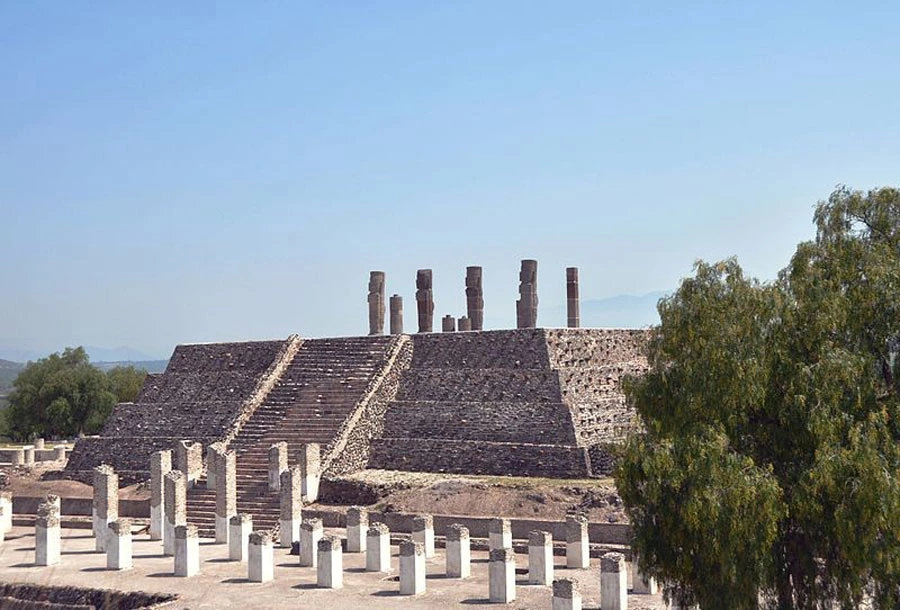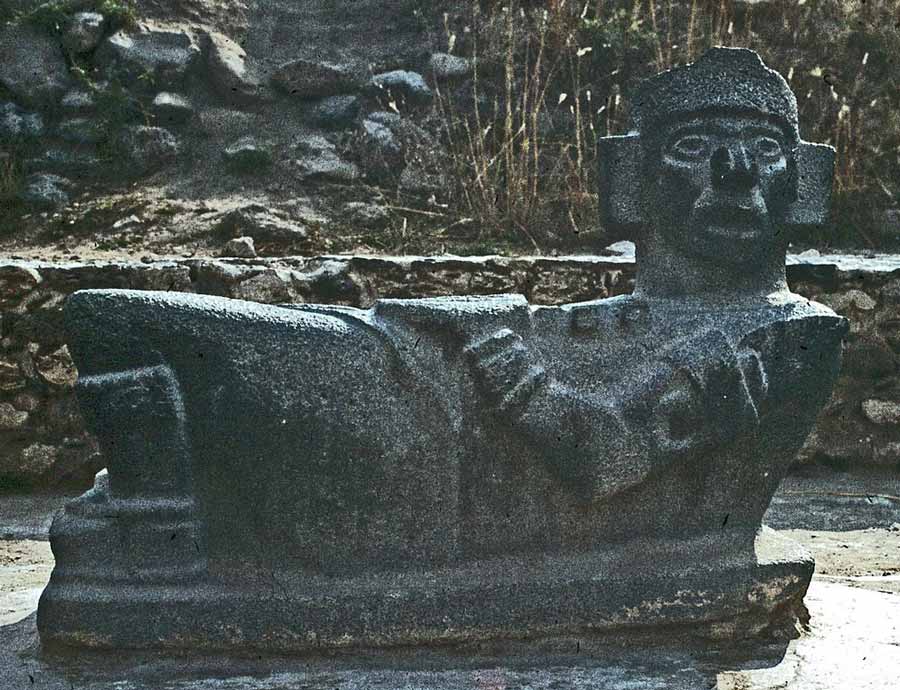When the first ships from 15th and 16th century Europe arrived in the New World, they encountered two mighty empires. In the south, based around the high Andes, were the Inca. And in Mesoamerica were the last of the great pre-Columbian civilizations, the Aztecs.
But timing, as always, is everything. Many empires had risen and fallen in the New World before contact with Europe. Some, such as the Puebloans or the Mississippians in what is now the United States fell less than a century before the arrival of Columbus.
Piecing together these lost civilizations was no easy task. For example, the Mesoamerican culture of Teotihuacan in Mexico left no written records and are as silent today as they were then. Others survived only through reputation, stories of lost cultures which would drive the invaders mad searching for the fountain of youth, or the golden El Dorado.
One such were the Toltec empire, the direct precursor to the Aztecs who revered them as demigods. Stories of their deeds grew in the telling, and eventually passed into legend. What then is the truth of these people?
Some things are clear about the Toltecs. They spoke Nahuatl, the lingua franca of Mesoamerica which was also used by the Aztecs. Their capital was the city of Tula, in central Mexico.

They clearly interacted with the Maya, the other great civilization of Mesoamerica, and Toltec architecture is evident at the great Maya city of Chichen Itza. And the word Toltec means “artisan” in Nahuatl, which is what the Aztecs called them. What they called themselves, we have no idea.
But who were the Toltec people? What was it about them that led to the Aztec worshipping them as figures of legend?
The Toltec Influence
The Toltec Empire ruled central Mesoamerica between 900 and 1150 AD. They were known to lead a rich religious life, and their civilization is marked by the widespread worship of that most flamboyant of Mesoamerican gods, the plumed serpent Quetzalcoatl.
Like the Aztecs, they put great emphasis on their warrior culture, prizing strength and martial prowess. And like the Aztecs, they practiced human sacrifice atop their great pyramids.
The early Aztec rulers, seeking legitimacy, would claim that they were descendants of the Toltecs. The Aztec empire, based in the lake Texcoco region, was in roughly the same place as the Toltecs, and claiming a direct link with these great people would grant reflected glory to the Aztecs.
- The Hidden River of Mercury at Teotihuacan: Path to the Royal Tombs?
- The Mayan Calendar Facts, Theories and Prophecies
And so, the Aztecs would copy a number of Toltec cultural customs, including human sacrifice as well as worship of Quetzalcoatl. They considered the Toltecs to be their predecessors and admired them. Workers were even sent to the ruined city of Tula by the Aztec rulers in order to retrieve sculptures and arts.
It paid to exaggerate the Toltec achievements as well. The greater the Toltecs had been, the greater the Aztec rulers who claimed descent from them would be. And so, the heart of Aztec culture can be said to be copied, and developed, from a people who died a century before.
The Toltec Civilization
Once separated from Aztec cultural appropriation, some facts about the Toltecs can be confirmed. They were a Mesoamerican culture which rose to prominence during 750 AD after the fall of Teotihuacan, the previous power in the region.
A warlike society that was ruled by priest-kings, they spread through the Yucatan peninsula with their cult of Quetzalcoatl. Their aggression changed the face of Mesoamerica, bringing in a new era of violence and militarism.
The Toltecs were notable craftsmen and builders, and left many monumental structures. They created gigantic statues, fine metalwork, serpent columns, monumental porticoes, and carved animal and human standard-bearers.
The Toltecs were not only conquerors however, and actively traded with their neighbors. Although their trade network was not on the same scale as the mighty (and more peaceful) Maya, evidence survives that the Toltecs did engage in trade with even far neighbors. Seashells from both Pacific and Atlantic species have been found in the city of Tula, and a number of pottery fragments from Gulf-Coast cultures have been identified.
The Toltecs traded in pottery and obsidian tools, but these were not the source of the wealth in their empire. As a warrior culture, most of their wealth came due to tribute and not trade.
The Religious Life of the Toltecs
The Toltecs were a highly militaristic society, but religion was the driving force behind their expansionism. Like the crusaders of Europe, theirs was a holy war.
The rulers of the Toltec civilization were also their high priests, thereby erasing the line between religious and civil rule. Most of the monumental buildings in their city of Tula were used for different religious functions. Around the central sacred precinct were various temples, as well as the inevitable Mesoamerican ball courts.

Toltec warrior (Ángel M. Felicísimo / CC BY 4.0)
A combination of modern archaeology and Aztec tradition even allows us to see what these religious warriors looked like. They wore chest plates, headdresses, and padded armor, and were heavily armed.
On one arm, they used to carry a small shield. They were also armed with a heavy curved bladed weapon, a short sword, and an “atlatl”, a weapon that was specially designed for throwing darts with great velocity.
- Olmec Civilization: Their Rise, Culture and Decline
- Cahokia Mounds: The Largest Ancient City in North America
The Toltec civilization had a number of gods. However, among all the gods, the chief were Quetzalcoatl, Tlaloc, and Tezcatlipoca. Quetzalcoatl was the most important god among the three.
Tezcatlipoca, known as the “smoking mirror” was a kind of brother god of Quetzalcoatl. At Tula, only one representation of Tezcatlipoca has been found. Tlaloc was known as the rain god and had been worshipped at Teotihuacan. As the Toltecs were successors of the Teotihuacan culture, they also worshipped the rain god.
Depictions of other gods have also been found at Tula, but the Toltec religion was based on these three. Even though the Toltecs had not created Quetzalcoatl, their reverence towards the god proliferated his worship.
Much evidence at Tula reveals Toltec religious practices as well, most notably the human sacrifice. On the main plaza’s western side, there was a skull rack named “tzompantli”. The skulls and heads of sacrificed victims were put on this rack for display.
Inside the “burned palace” at the center of Tula, there were three distinctive reclining statues known as “chac mool”. The reclining figures had bowls in which the heart of the human was placed.

Depictions of the large eagle vessels or “cuauhxicalli” were also found in Tula that are believed to have been used in order to hold the human sacrifices. They were mainly engaged in human sacrifice in order to please their gods.
Passing into Legend
Sadly, what happened to the Toltec culture is something of a mystery. The civilization declined by 1150 AD, and Tula was eventually abandoned and later burned down to the ground.
The burned palace was one of the important ceremonial centers that were so named owing to the charred bits of wood found there. But very little information is available as to who burned Tula and for what reason. On this the Aztecs are silent, preferring to gloss over the fall of their heroes.
One of the possibilities is that as the Toltecs were known to be violent and aggressive people, there is a chance that the neighboring states or tribes could have retaliated. Moreover, a number of historians believe that it could be a result of internal strife or civil wars.
With the loss of the Toltec culture, a power vacuum was created in the region which paved the way for the rise of the Aztecs. Seeking to copy and borrow from their predecessors in Mesoamerica, their stories of the Toltec priest-kings and mighty warriors passed into legend.
Why did the Aztecs worship the Toltecs? Because they wanted to be just like them.
Top Image: Toltec statues at Tula, Mexico. Source: soft_light / Adobe Stock.
By Bipin Dimri